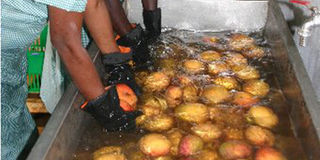You can do so much with fruits for more value

Female workers busy cleaning mangoes before the fruits are crushed
into juice in the second week since the opening of the Malindi Farmers
Cooperative Society Sh75 million plant which has been crushing 60
tonnes of raw mangoes every day since it was opened. PHOTO|ROBERT NYAGAH|NATION
What you need to know:
- Fruit jams are a major way farmers can add value to their produce and earn more money.
- To make the jam reach the ‘setting’ stage, one can add a handful of citrus fruit seeds to the boiling pulp in a small cotton or net bag. The pectin from the seeds helps the jam set.
- Fruits with less acid require pectin to set whereas jams from acidic citrus fruits generally do not require it.
The fresh fruit business is high-risk and unstable because of the seasonality and perishability of the produce.
Therefore, post-harvest losses are normally high, especially during transport, when off-loading and when the produce fails to get market.
Majority of farmers sell their produce either on the farm or through local markets, exposing themselves to exploitation by middlemen due to perishability of their fruits.
But such losses can be minimised if farmers embraced value addition.
Fruit jams are a major way farmers can add value to their produce and earn more money.
The jam is a thick puree mixture of fruit, sugar and often pectin.
The process starts with one selecting fresh ripe fruits followed by washing and drying before removing the seeds. Then add equal amounts of sugar to the fruit pulp.
Add lemon seeds and boil until it passes the ‘setting test’, which proves the jam is ready.
Process of making fruit jam
In jam making, the ‘setting test’ is where a teaspoon of jam is dripped onto a clean glass plate. The jam is then cooled before the plate is lifted and slanted.
If the jam slides down the plate, then it is not ready. If it moves slowly and is jelly like and sticky, it is ready.
To make the jam reach the ‘setting’ stage, one can add a handful of citrus fruit seeds to the boiling pulp in a small cotton or net bag. The pectin from the seeds helps the jam set.
After the boiling, the seeds should be removed and thrown away. Modern jam making recipes regularly require one to add a commercially available setting agent, normally natural pectin.
The more pectin one adds, the faster a jam should set thus the shorter the ‘cooking time’. A jam that has set is ready for packaging.
Jam jars and lids should be sterilised by boiling in water for five minutes and leaving to drip dry.
Fill the jam in the jars when it is still hot, thereafter, immerse the container into boiling water for 10 minutes to ensure pasteurisation.
Remove the jars from the boiling water and allow it to cool before labelling. Jams should be stored in a cool place before transportation to market.
Fruits with less acid require pectin
Different fruits have different sugar and acidity levels. Fruits with less acid require pectin to set whereas jams from acidic citrus fruits generally do not require it.
Jams from citrus fruits are referred to as marmalades and can be made inclusive or exclusive of the fruit peels.
Marmalades that combine the skins of the fruits have to some extent bitter taste due to the citrus oils in the skin. This can be avoided by peeling the fruit. Jams can be made from the following fruits; plums, apples, pineapples, guavas, strawberries, raspberries, mulberries, papaya and mangoes.
On the other hand, marmalades can be made from the following citrus fruits; limes, lemons, oranges and grapefruit. Jams are normally used as bread or toast spreads and dessert sweeteners.
However, it has many other uses including acting as a great pancake topping. It could also be used as a sweetener in hot tea.
A mixture of one tablespoon of jam to one tablespoon vinegar and three tablespoons oil makes a good salad dressing. Jams are also used to make simple syrup for cocktails whereby a tablespoon is placed in a shot glass and covered with vodka or rum.
The writer is based at the Department of Dairy and Food Science, Egerton University.




